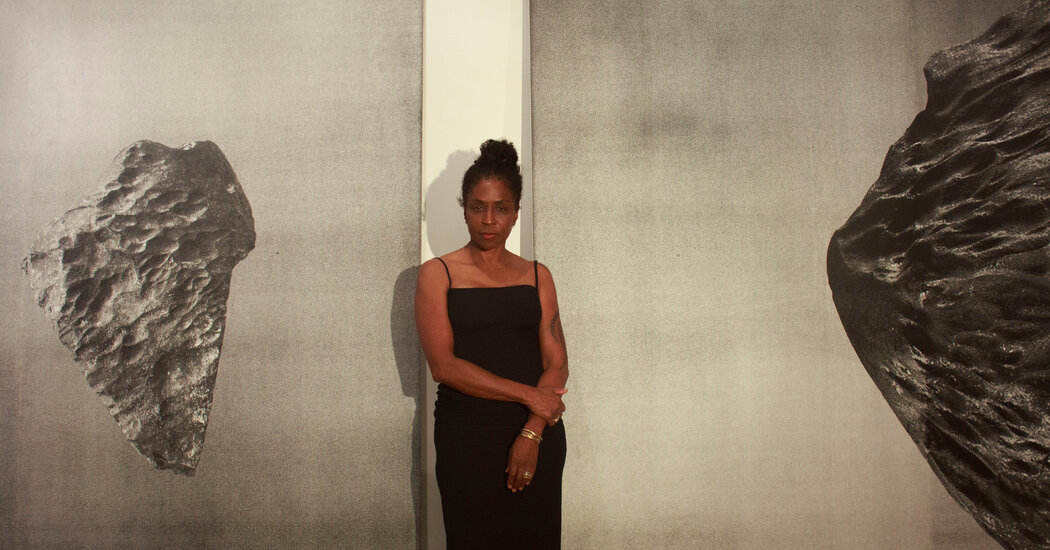O winged Lady,
Like a bird
You scavenge the land.
Like a charging storm
You charge,
Like a roaring storm
You roar,
You thunder in thunder,
Snort in rampaging winds.
Your feet are continually restless.
Carrying your harp of sighs,
You breathe out the music of mourning.— from “Hymn to Inanna” by Enheduanna,
translated from the Sumerian by Jane Hirshfield
PROPHETESS
ONE RISKS ANGERING the gods if one visits an oracle empty-handed. When I rang the Camberwell, South London, doorbell of Florence Welch, I held a tribute: “The Penguin Book of Spiritual Verse” (2022), edited by Kaveh Akbar. It has a poem in it by Enheduanna, the first named poet in written historical records, a Sumerian princess and priestess who lived over 4,000 years ago. Ancient priestesses made their bodies a conduit for collective transcendence and, now that the old gods have abandoned us, we secular souls tend to find our collective transcendence at concerts. I’ve never seen Welch’s band, Florence and the Machine, perform live, only on YouTube, I’ve only heard her music streaming on repeat for years, and yet I often find myself carried out of my body by Welch’s enormous voice, her rage and power. There’s a sizzling line that starts with Enheduanna and runs all the way to Welch; they’re both performers of spiritual enormity who, through incantation of words, open a channel to vast mysteries.
What was I expecting? Impossibilities. A modern Madame Blavatsky all dressed in gauze, trembling shadows, eyes like dark whirlpools. Instead, on that July day, after her assistant let me in, Welch ran up from her garden a creature of flesh and blood, wearing a prim prairie dress with flowers speckled all over it. She is tall — somewhere near 5-foot-10 — ardent and elegant, with long red Pre-Raphaelite hair and the strong-boned face of a medieval saint. She has an incredible vigor to her speech, which is frequently crowded with images. She was talking even before coming into the room and spoke nonstop for hours, thoughtfully, in loops and circuits; I only interjected a few times. With other people, being monologued at like this might have been hellish, but Welch was a little goofy, quite funny — her laugh is deep, sudden, frequent and startlingly loud. On multiple occasions during our hours together, she paced in excitement. Once she sped off upstairs to fetch something, coming down the staircase with such fast footsteps that I was briefly afraid she’d tumble the rest of the way.
“Poems!” said Welch, flipping through the book I brought. “Great!” And then in a flash the book vanished, never to be seen again.
The singer on the Fleetwood Mac song that feels like riding a roller coaster.
In fairness, a single book would be easily lost among the stuffed bookshelves everywhere in her house. Welch is a real reader: She presides over a book club called Between Two Books and, in full disclosure, drew from my 2018 short story collection, “Florida,” when she was writing lyrics for the song “Florida!!!,” her 2024 collaboration with Taylor Swift. Her rooms replicate her maximalist, ecstatic music: high ceilings; many paintings and drawings; thick woolen Oriental rugs. Everything is layered and made of complex patterns, with William Morris prints and hand-marbled boxes in intense colors like peacock blue, goldenrod, raspberry sorbet.
Because the best way is often straight through, I tried to start our conversation with a question about mysticism, but she refused to be boxed in. She said, laughing, that she can read tarot, but she refused to define her spirituality, beyond repeating a quip of her mother, Evelyn Welch’s, a Renaissance expert and currently the vice chancellor of the University of Bristol, who called her daughter “an animist.” Maybe she meant that, to her daughter, things like sunlight and the ocean have a soul. Welch’s earliest spiritual moment came when she was an imaginative small child in Camberwell — where her parents lived, not far from her current house — just looking at beams of light coming through her bedroom window and feeling connected to something larger.
Chanel coat, price on request, (800) 550-0005; Valentino tights (worn underneath), $1,000; and Welch’s own dress, headband and jewelry.
Photograph by Luis Alberto Rodriguez. Styled by Vanessa Reid
This resistance to being pigeonholed would become a motif of our weekend: Welch wouldn’t say whom she was dating, only that he was a British guitarist, so that she wouldn’t be defined by her relationship (honestly, good for her!); she’s as vulnerable and honest as an incredibly famous human could possibly be: She gently but firmly resisted every time I tried to ask if she considered herself a pop star, or even what kind of music, actually, she would say she makes.
An aversion to definition is a great gift to an artist like Welch. It allows her to change and grow in public. But it’s an equal source of confusion to critics, who’ve struggled to place her since the first of her five albums, 2009’s “Lungs.” Of course, no artist is truly sui generis — art is built out of other art — but it’s odd that Welch so confounds critics with her mix of soul and goth-punk and ethereal power ballads, as well as the way that she presents herself as closer kin to 1960s rock goddesses than to the hyperproduced pop stars of today, that the aforementioned critics have only rarely likened her to the musicians who’ve been her truest influences. Among these are Nick Cave, Patti Smith, Stevie Nicks, Tom Waits, Jeff Buckley, Sam Cooke and Otis Redding, whose live version of 1967’s “Try a Little Tenderness” Welch watched obsessively on YouTube in her early 20s when she was teaching herself how to perform, his energy building as the song goes until, she said, “he just tears the stage apart.”
Perhaps it’s enough to say that Welch has one of the most distinctively powerful voices in popular music. My friend the 33-year-old performer Ganavya Doraiswamy, who’s trained in both jazz and South Asian devotional singing — the only other person I’ve ever met with a voice whose power and distinctiveness could match Welch’s — said that she has uyir, Tamil for “life breath,” in her voice, which Doraiswamy was trained to listen for as the soul of vocal art. “It sounds sometimes like [she] is singing to herself and we get to listen in, like we are privy to someone singing to themselves, and they’re making the world less unbearable,” she said. Uyir seems to be something like Federico García Lorca’s duende, of which the great Spanish poet said in a 1933 lecture, “All that has dark sounds has duende. … The duende is a force not a labor, a struggle not a thought. I heard an old maestro of the guitar say: ‘The duende is not in the throat: the duende surges up, inside, from the soles of the feet.’ Meaning, it’s not a question of skill but of a style that’s truly alive: meaning, it’s in the veins: meaning, it’s of the most ancient culture of immediate creation.”
Uyir and duende may be lofty claims to make of a creator and performer of pop songs, but we have all been brainwashed to discount popular culture because of its very popularity, to believe that anything beloved by the masses is inherently lesser than esoteric art. This is a begging-the-question fallacy disproved all the time by great popular geniuses like Shakespeare, Mozart, Toni Morrison, Lorca himself. The music of Florence and the Machine is ubiquitous — the night before I left Florida for London, some stranger covered 2008’s “Dog Days Are Over” at karaoke; the band’s 2011 “Shake It Out” was piped over the loudspeakers while I waited for my plane in the airport — and it is excellent. It’s absurd to have to insist that both popularity and excellence can coexist.
The music’s ubiquity is perhaps because of the fact that Florence and the Machine sound like nothing else out there in the musical landscape. It’s also, perhaps, because of the spooky vastness of Welch’s vision. Jack Antonoff, the 40-year-old producer and musician with whom Welch worked on her last album, 2022’s “Dance Fever,” said that she might be “literally clairvoyant.” And it’s true: Over and over, her songs predict the world to come. For instance, she wrote the lyrics for several of the album’s songs in 2019, including those of “Choreomania,” a song that Welch based on the 1518 dancing sickness in Strasbourg, where people actually danced until they died. The lyrics, with their frantic repetition of “Something’s coming, so out of breath” became prophetic when Covid-19 started spreading in 2020. “I didn’t know exactly what was coming,” Welch said, “but I knew it was dark.”
Welch may not call herself spiritual, but the thing she kept pulling herself away from speaking about is the thing at the center of her, which she sometimes calls “the monster,” sometimes “the beast.” She struggles to control it, but it seems to be the source of her creative energy. “The beast is very good when it’s onstage. The monster is really useful and full of rage and glory and power,” she said. But as soon as she began talking about the beast, she grew agitated; it felt wrong. Her spiritual sense “doesn’t feel like something I should advertise, because it’s really sacred,” she told me, and changed the topic once more.
When an oracle hears the voice of God and shares what she heard with others, she’s doing the same thing that an artist does while making art. Art is the alchemy by which grand abstractions become material. More than anything else, art requires the body of the artist, readied through time and practice and effort and some sort of innate spark, to become a sort of portal. Welch steps onstage and this portal is immediately available to her. To have the kind of transparency and vulnerability that allows such immediate access to the eternal, mysterious energy requires a great deal from the artist. Which is to say that art so powerful and immediate is demonic in its demands on the small, fleshly human that holds it.
Ferragamo dress, $5,000, ferragamo.com; Chanel hat, $4,500; and Welch’s own shawl.
Photograph by Luis Alberto Rodriguez. Styled by Vanessa Reid
HARP OF SIGHS
HOW DO YOU build a modern priestess? Welch was born like ordinary humans in August 1986; she’s currently 38. Her father, Nick Welch, is a former British advertising executive and, as his daughter called him, “bohemian”; he was the one who introduced her to bands like the Ramones and the Smiths when she was little. Through her mother’s specialty in Renaissance history, as well as family visits to ancient churches, Welch was deeply impressed as a child by the glorious, gory, vermilion-and-gold Catholic imagery, with its St. Sebastians pierced by arrows and St. Agathas with breasts on platters. She loved Greek mythology, she loved history. But nightmares plagued even her daylight hours, and her only escape from the monsters, ghosts and demons that her anxiety summoned was into books. Her mother wanted her to be an academic, but Welch was a daydreamer and had difficulty at school, having dyslexia, dyspraxia and something close to dyscalculia, and she would sneak out of the classroom to sing in the school hallways where the acoustics were good.
Even when Welch was small, she had a Big Voice. She showed me a photo of herself as this little girl in a gingham dress, clutching a trophy for singing. The voice that “came out of that was oddly adult, sensual,” she said. Her mother was always yelling at her to shut up because she’d be singing at the top of her lungs while her mother was trying to write her books. It turns out that the Big Voice is as much a physiological gift as it is a vocation: Welch has a strong diaphragm, a large rib cage with huge lung capacity — which makes finding the vintage dresses that she loves tricky — as well as vocal cords of titanium. Once, fearing that she was losing her voice on tour, she went to see a specialist in Toronto, who looked down her throat only to respond, “Oh, yeah, your vocal cords are like a tank. You’re never gonna lose your voice,” she said. Music was the only thing she ever wanted to do, “Like, I will die if I don’t do it,” she said; singing was the companion that kept her from being alone with the terror. She longed to be in musical theater, but her mother was “the opposite of a stage mom,” Welch added dryly, and only reluctantly conceded to classical voice lessons. The singer trained in opera as a soprano and was only allowed to belt out a Disney song or show tune at the end of her lessons.
The first time she appeared onstage, it was in a school performance of the musical “Bugsy Malone” (1976), and she blew everyone out of the water. “From a really young age, probably like 10, we knew that she was going to be really famous,” said her sister, Grace, who is younger than Welch by three years. (They have a brother, as well, and three stepsiblings.) Welch was hurt after their parents divorced when she was 10, the couple suffering from “simmering, silent resentment but no fights,” she said. She developed an eating disorder when she was a young adolescent. Then, when she was 14, she had her first taste of vodka and felt herself rise, transcendent, out of her anxieties. “Somehow alcohol allowed me to expand, to have freedom from the constraints of the body,” she said. “The first time I had hard spirits, it felt spiritual. I felt warm, I felt free, I felt at peace. It freed me from the relentlessness of thoughts.”
All Welch wants is the grace that male performers get. The grace to age in public; the grace to put art at the center of one’s life and not have to be a woman or a mother first.
Suddenly she was a party girl, dancing barefoot over broken glass in nightclubs in ripped vintage dresses. She bartended for a year after secondary school and got deeper into the “doomed Dickensian pirate ship,” as she described it, that was the South London music scene in the early 2000s, when rebellious young artists lived in squats. Welch, like the rest of them, drank to excess and screamed onstage in punk bands. She entered Camberwell College of Arts but dropped out after one year. As a teenager, she also experimented with folk, country and hip-hop-influenced rock. She got her first gig by singing in a nightclub bathroom — more good acoustics — and called her band the Machine after the nickname of one of its long-term members, Isabella Summers, who was a close co-writer, producer and collaborator on the first few albums but hasn’t been involved in the most recent ones. While still a teenager, Welch co-wrote the first song — the punk-pop “Kiss With a Fist” — that, after the band was signed in 2008, became big for them worldwide.
“Lungs,” released the next year, is very much a first album, exuberant in its range of styles. “Dog Days Are Over” was the second single, and the first song that would contain everything that Welch’s music has become known for: intense and pure feeling; elliptical lyrics; strange, catchy drums; a tune that starts soft and builds into a great crescendo of sound. Again, critics didn’t get the album — they likened Welch to Fiona Apple, Kate Bush, Regina Spektor, Annie Lennox, Joanna Newsom, Sinead O’Connor, artists whose music has very little to do with one another’s but, well, they’re songwriters and women at the same time, so they must be similar! Some critics were weirdly condescending in their incomprehension: One wrote in Rolling Stone that the “best bits feel like being chased through a moonless night by a sexy moor witch,” which … what is that supposed to sound like? Screaming in terror while trying to run with an erection?
The pressure of new fame was so intense that the singer kept dancing with self-destruction. “In order to protect myself from the public gaze,” she said, “I shrank myself offstage.” When she and her band were working on what would become their first singles, her partying was so out of hand that she nearly blew it with the record company; she was too much of a liability, disappearing for three days into a bender and showing up at a pub mysteriously covered in blue paint. She was also in thrall to an eating disorder, a way to try to impose control on a life that felt uncontrollable. Grace became her personal assistant, and a great deal of the burden of the singer’s bad behavior fell on her. Grace loved her sister, looked up to her and now regrets bitterly how she enabled her. Welch lost days partying, blackout drunk, on drugs. Grace says now that the family has “this joke, like, ‘Thank God she was famous.’ She’s always been supercreative and supercomplicated and supertroubled, and if she didn’t have all that money and, like, a team of people propping her up in her 20s, she’d totally be dead.” Back then, Welch still lived at the family home in Camberwell; she’s an artist who needs to be rooted in place to make her art and hasn’t ever moved away from the neighborhood. Still, no matter how drunk or brutally hung over she was, she was always able to get up onstage and perform.
There’s a rigid cycle in music making: One starts in the studio, creating the songs, which at this point with streaming are practically given away for free; to make money, one has to embark on a grueling two- to three-year schedule of performances, a lifestyle that lends itself easily to drugs and alcohol. Performing in massive venues is hugely physically taxing, particularly when one does it with Welch’s commitment. She throws her entire body into her songs, dances barefoot because she needs to feel the ground beneath her. She has twice broken her foot midway through her concerts but never stopped, instead singing through the pain. A great performer is something of an energy worker, creating a collective experience through her voice and body, and energy needs to be rebuilt before it’s expended again. She tried to control her alcoholism by not drinking when she was performing, but that was worse: She began to binge when she wasn’t on tour.
In 2011, the band released the album “Ceremonials,” which Welch described as a “wall of sound, a wall of aesthetic,” a tumultuous wrestling with her addiction. “I was wandering around like a superhigh Gustav Klimt painting,” she said. The recurrent imagery is that of drowning; in the single “Shake It Out,” the line “It’s hard to dance with a devil on your back” repeats so often it becomes almost frantic.
Not long after, on the singer’s 27th birthday, her mother gave a moving speech, begging her daughter not to join the 27 Club, the group of tormented artists who’d died as a result of addiction, the rock ’n’ roll lifestyle and the radical exposure it requires to be an artist at that age: Jimi Hendrix, Janis Joplin, Jim Morrison, Kurt Cobain. Welch had shown up to her birthday party drunk and high. Perhaps because of the immensity of her shame, she smashed her whole face into her birthday cake.
There was a moment in the months afterward, lying on the floor of her room, that Welch began to tell me about, saying that she was praying, “Help me, please help me, help me, help me,” but then she trailed off. One doesn’t speak about the holy. “It feels like a betrayal to the thing that helped me,” she said. In any event, after that night, Welch became sober.
For a year, the singer was a “completely broken person,” she said. She’d always loved clothes, had delighted in her dresses onstage, but now she wore the same “horrible blue tracksuit” everywhere. Later on, she had treatment for her eating disorder. When I asked her what had taken the place of the addictions, she told me matter-of-factly, “The performance. The music.”
The albums that came afterward were a kind of resetting. For 2015’s “How Big, How Blue, How Beautiful,” Welch had just been broken up with and had herself broken up with drugs and alcohol. As a result, the music was stripped down instrumentally, the cover image was black and white and onstage she wore a more masculine suit instead of her previous flowy dresses. Welch was, perhaps not coincidentally, taken more seriously as an artist. When Dave Grohl of the Foo Fighters broke his leg and the band had to pull out of headlining the 2015 Glastonbury Festival, Florence and the Machine were asked to replace them. She began to write more poetry. In 2018, Florence and the Machine released “High as Hope,” which is even more stripped down and intimate, with Welch’s poetry becoming its lyrics.
In addition to her albums, the singer has been working for eight years on a musical version of F. Scott Fitzgerald’s 1925 novel, “The Great Gatsby,” called “Gatsby: An American Myth,” which I saw in June at the American Repertory Theater in Cambridge, Mass. She was drawn to the book, she said, by the drunkenness and hangover in it, the doomed romanticism, “the way the page sings.” The show got a standing ovation. I thought it was fine. At times, everything was so on the nose that I felt I was being hit with a soft right hook. The set is half nightclub, half car crash, just like the Roaring Twenties; all the characters’ costumes have dirty hems, as though to semaphore that none of them have quite risen above the muck of the American dream. The music is a collaboration between Welch and Thomas Bartlett, who, in addition to being a co-producer and co-writer on some songs on Florence and the Machine’s “High as Hope,” is a gifted musician who’s worked with everyone from Nico Muhly to Yoko Ono and Sufjan Stevens. The songs they made are excellent and surprising, with exciting and slithery Jazz Age rhythms. But art gets in trouble when it becomes polemical, which many of the songs were. I began to wonder if a musical would ever be the right vehicle for a story like “The Great Gatsby.” Musical theater is the most American art form that exists, all dazzle and jazz hands, but Fitzgerald’s novel draws its power from the lightness of its allusions. Things that are hinted at in the book — like Nick Carraway’s crush on Jay Gatsby, or Gatsby’s gangster past — get their own numbers. That said, songs are still being made and discarded. The version I saw, which might one day move to Broadway, hadn’t settled into its final form, and it’s a sin to judge art before it’s finished.
Welch’s most recent album, “Dance Fever,” is my favorite; I played it so often that my younger son began to call it “Mommy’s church.” I find it almost unbearably beautiful, a confirmation that Welch’s songwriting keeps getting more powerful. She had already written the first two songs — “King” and “Free” — and was in the studio in New York City in March 2020 with Antonoff when the pandemic hit, and they had to flee to their respective corners. The rest of the songs arrived as Welch’s anxiety spiraled in her London home, the project something of a diary of those years of isolation. Listening now, it feels like a wild, anxious, terrified, hedonistic catharsis of that awful time, a ritual cleansing of the collective grief that we still haven’t fully processed as a culture.
Louis Vuitton dress, price on request, louisvuitton.com; and Welch’s own dress (worn underneath) and jewelry.
Photograph by Luis Alberto Rodriguez. Styled by Vanessa Reid
PORTRAITURE
THE DAY AFTER I visited her house, I met Welch at the Tate Britain to see a John Singer Sargent exhibition. The turn-of-the-20th-century portraits were huge and dramatic and vividly emotional, the rooms thickly crowded. I said I loved the subjects’ expressions; Sargent was a master of distilling character in the subtle look on a face. “I love the fashion,” Welch responded and gestured at “Portrait of Miss Elsie Palmer” (1889-90), depicting a young American girl with reddish hair and bangs like Welch’s, wearing a layered pale pink dress with a pleated underskirt and bodice, her waist tightly cinched.
As we walked, astonishment took hold in me that nobody seemed to recognize the superstar beside me. I’d been sure we’d be so swarmed that I’d had fantasies I’d have to double as a bodyguard, fending fans off with my enormous Muji notebook. But no one did, despite the fact that Welch was on such a state of hyperalert that, when I once tried to take a photo of a stunning Sargent dress on a dummy and her head happened to be in the frame, she swiveled so fast toward me and gave me a look of such searing disdain that I felt flayed. The monster had risen up in her face for a moment. It was terrifying.
Perhaps people in crowds at art museums are deeply unobservant of those around them, only anxious to see the works on the wall; perhaps it was because, with her pale, thin elegance and her feminine dress — delicate flowers on a green field, discreet ruffles and a filigree of off-white lace — she looked as though she were herself a Sargent subject stepping out of the frame. Most likely, however, it was because Welch has built such a powerful public image, a glamorous pagan priestess hologram, that the human person behind it simply didn’t square. Maybe her fans didn’t recognize her because the performer is a giantess and the person is merely person-size.
The image of Florence and the Machine is a curious thing. It’s intricate and carefully constructed, vivid and clear in its referents and set intentionally outside of the contemporary moment, which allows the singer to change and refine the way she presents herself to the world. She seized on it early, after some industry people’s unhappy experiments with trying to market the young singer-songwriter in miniskirts and high-heeled shoes. But she couldn’t sell sex. “I’ve always looked like a haunted painting,” she said, and it’s true that, though she’s beautiful, a bad photograph would show her features as harsh, stern. She also didn’t want to sell sex: “I wanted to be scary when I was younger, not sexy.”
To refuse to do so was intentional; it was also lucky. A female artist who’s marketed as sexy must stay at the same level of sexy even as she ages, which is increasingly hard to do, what with gravity and slipping hormones and the frankly fascinating processes of living beyond the body’s natural fertility. Britney Spears will never not exist in the public imagination as a nubile teen in a schoolgirl kilt. Dolly Parton is closing in on 80 with the same blond bouffant and enhanced breasts that she once, at an awards ceremony, called “Shock” and “Awe.” I’d never judge any performer for using her sexuality to sell records; trying to sell art at all is a grind, particularly at the beginning of one’s career, and if the universe has given you a gift of such reach and power, it would be difficult not to use it. But this form of beauty is something of a gilded cage, a safe place for a little time, though also a trap that a woman can’t escape.
Chloé dress, $6,490, and dress (worn underneath), $3,990, chloe.com; and Welch’s own crown, shawl and jewelry.
Photograph by Luis Alberto Rodriguez. Styled by Vanessa Reid
Instead of selling a sexualized image, Welch, with the collaboration of music video and photography directors, has created a visual world that’s been seized on by her fans and replicated at her concerts, which can resemble teeming fantasy fashion shows. From the stage, she can look out on a sea of bloody prairie maidens with flower crowns, mermaids with sharp teeth, weeping martyrs, witches in purple silken cloaks, Jesus, tattered ghosts, all images from her songs and videos. Autumn de Wilde, 54, first directed Welch in the 2018 music video for “Big God,” which is shot as though in outer space, on a stark black stage in a shining one-inch pool of water pierced with high-contrast light. As Welch sings, the dancers’ colorful veils darken as they get wet, then are discarded, until at last Welch levitates the dancers with her voice. “Given the opportunity,” de Wilde said, “if you put her in any world, she will make it iconic and gigantic. You can’t have that without her vulnerability.” The Florence and the Machine aesthetic draws from Pre-Raphaelite tawny goddesses; photos by the 19th-century artist Julia Margaret Cameron; Surrealist 20th-century paintings by Leonora Carrington and Remedios Varo; the modern dancer Loie Fuller; exhausted cancan dancers; pastel moths. All come from the same spiritual universe, as dark as true fairy tales tend to be, confections of extreme beauty with neon venom laced through.
It wasn’t until I spoke with de Wilde that I changed my mind about Welch’s image; at first I thought she wielded it like a shield, meaning that she’d constructed it purely to protect the fragility beneath. After, I saw it was something of a seashell, all spikes, dazzling colors, mother-of-pearl gleam. Both shield and shell are created in order to protect the tender flesh within, but a shield is the result of a huge amount of human labor, mining and refining and beating of the hot metal, and a shell is a natural emanation of the beast that builds it. Florence and the Machine is the singer’s true self, but writ large, her imagination allowed freedom to play. The child who spent hours gazing at the light in her room has taken her visions of monsters and saints and demons and graces and made them real.
One of the final portraits at the Sargent show was the well-known “Ellen Terry as Lady MacBeth” (1889), the actress bloody mouthed, with long red braids to her knees, wearing a shining green-and-gold dress, placing a crown upon her head. “We drew on this painting a lot to build our look for ‘Dance Fever,’” Welch told me quietly, smiling.
At this — seeing the queen, her face become a stark mask of ambition — I had a powerful moment of déjà vu. I thought of the lyrics to “King,” when, at the beginning, Welch sings in a low register: “We argue in the kitchen about whether to have children / about the world ending, and the scale of my ambition / And how much art is really worth / The very thing you’re best at is the thing that hurts the most.”
Christ on a stick! Show me another popular song that speaks in such a compact way of such vast things: the moral burden of bringing children into the Anthropocene, huge ambition in a female artist, how it’s all complicated when one considers a baby’s hijacking of the body for 40 weeks — and beyond, if the mother is nursing. There are so few examples of female musicians who were able to uphold a rigorous touring schedule after they’d had children that Welch and I could only think of one: Beyoncé. Exacerbating the mixed craving for and fear of having a baby and what it would mean for her art, Welch feels the intense pressure of aging as a female performer. “At 40, what are you supposed to do? Die?” she asked, then laughed darkly. “King” goes on to insist, “I am no mother, I am no bride, I am king.” She isn’t a queen, accessory to power; she’s power itself. “I was also thinking of the King of Rock,” Welch said, referring to Elvis Presley; she was thinking of the right of male artists to let their art be separate from the body, to let the art be so central that everything else is peripheral. In the latter part of the song, Welch raises her voice in a long howl of rage. Maybe I revel in her work because so much of it is simply overflowing with rage, her perfect voice embodying all that subsumed rage that I swallow every day and allowing it to bloom out into the world, a gorgeous shining pitch-black flower.
All Welch wants is the grace that male performers get. The grace to age in public; the grace to put art at the center of one’s life and not have to be a woman or a mother first. If the universe gives an artist the nearly unlimited ability to become a conduit to the astonishing eternal mysteries, what a grinding check to her momentum when she bumps up against human-imposed boundaries of misogyny. How much worse must be the body’s own betrayal! How enraging that, even as an artist earns more wisdom and depth and artistry — begins to understand how to pull the uncanny powers of the beyond down into constant display on the earth — the body begins to lose its vital energy, and the cost of being alive begins to wear you down.
Art begins in the body; art is limited by the limitations of the body; at some point, art exceeds the body and can live beyond the scope of flesh. I watched Welch look deeply at the gothic, gory Sargent painting of Ellen Terry, and I saw — or imagined I saw — the beast in her surfacing for a moment, hungry for the magic that Sargent enacted on his subjects, allowing them to be fully seen, to be held in the brightest of colors, to be shown to the world eternal in the moment of their greatest glory. Among the many other things Welch refuses to be defined by, she refuses to be defined by time. The tragedy of the Cumean Sibyl, according to the ancient Roman poet Ovid, was that, though the god Apollo did cede to her pleas to give her life beyond the scope of the mortal span, over a thousand years her body shrank until only her voice remained. This is the fate of all artists. All have to come to terms with it at some point. Welch, preternaturally gifted as she is, isn’t exempt.
But until then, oh, you gods who power her, oh, you humans who make her life hum, just let the woman sing.
Hair by Anthony Turner at Jolly Collective. Makeup by Thom Walker at Art + Commerce. Set design by Afra Zamara at Second Name. Production: Farago Projects. Lighting technician: Jack Symes. Digital tech: Sam Hearn. Photo assistants: Daiki Tajima, Federico Covarelli. Manicurist: Emily Rose Lansley at The Wall Group. Hairstylist’s assistant: John Allan. Makeup assistant: Samanta Falcone. Set designer’s assistant: Ollie Kariel. Tailor: Pip Long at Karen Avenell. Styling assistants: Andreea Georgiana Rădoi, Sam Wright







